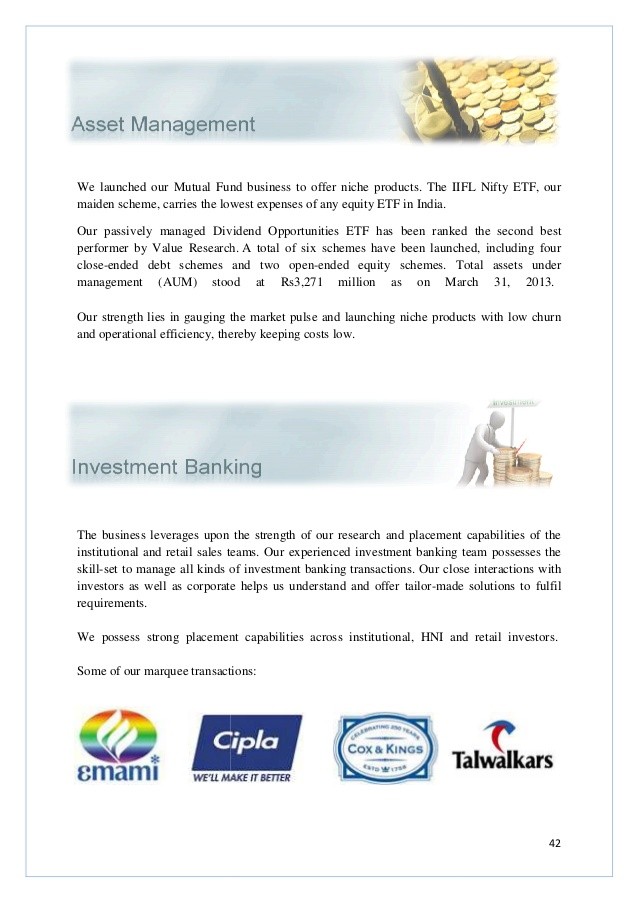ETFs An Introduction and Discussion of This Commonly Used Security
Post on: 10 Апрель, 2015 No Comment

ETF is an abbreviation for Exchange Traded Funds. They are a type of security that became popular in the 1990s as investors looked for new strategies to mimic the performance of a sector, a commodity or an index. They are traded on a stock exchange, which provides accessibility and liquidity to investors. They distribute dividends that the securities in the fund pay to the fund.
An ETF is similar to a mutual fund. However, the management fee for an ETF is only a fraction of what it is for mutual funds. A typical mutual fund manager charges clients 1-2% of the funds value as management fees, whereas an ETF manager only charges around 0.1-0.5% of Net asset value (NAV). Similarly to a mutual fund, an ETF will rebalance its portfolio by buying new assets and selling some old ones to better reflect the underlying asset it is tracking.
Types of ETFs:
There are different types of ETFs. Some are bond funds that track a bond index; others are equity funds that track an equity index; and yet others are commodity funds that track particular commodities and there are also some that track currency movements. For example, the United States Oil Fund (USO) tracks the NYMEX light sweet crude oil price (front month contract). This allows an investor in the stock market to invest in the oil market without buying futures contracts. A bond fund like the ishares Barclays 7-10 year ETF (IEF) tracks the Barclays capital 7-10 Treasury Bond Index which gives investors exposure to US treasury bonds maturing in 7 to 10 years. The SPDR S&P500 ETF allows investors to invest in the S&P500 index. The most interesting ETF is the iPath S&P500 VIX ETF (VXX) which tracks the short term CBOE Volatility Index (VIX) future contracts so investors can actually invest in stock market volatility.
Uses of ETFs:
The main use of ETFs is to diversify a portfolio. The old adage Dont put all your eggs in one basket identifies a strong motivator for the creation of ETFs. They track larger and broader indices and provide investors with the necessary option of investing in a wide variety of options to serve the essential purpose of lowering the overall risk associated with an investment portfolio. A technology enthusiast who wishes to invest in only technology companies can accomplish his or her goal easily by purchasing a technology sector ETF such as the XLK. The XLK holds shares in all the big technology companies including Microsoft (MSFT), Oracle (ORCL), Apple (AAPL), Google (GOOG), Intel (INTC), IBM (IBM), and HP (HPQ). By purchasing the ETF, the investor does not have to cherry pick individual stocks if that investor is singularly interested in technology stocks. There are similar sector ETFs for other sectors such as the XLE and XEG for energy, XLF and XFN for financials, and XME and XMA for materials.
Another use of ETFs is to hedge risk. One of the most important risks to an individual investor is market risk; the risk that the decline in overall market indices will decrease the demand for individual stocks. If an investor wishes to hedge the risk associated with a US equity portfolio, an ETF such as SH will decrease the losses for a portfolio during bear markets. If an investor has a US equity portfolio and wish to hedge against an adverse move by the Canadian dollar, that investor could buy the FCX currency ETF to hedge against a rise in the value of the Canadian dollar, which would reduce the return if converted back to Canadian dollars.
Lastly, sophisticated investors and traders use ETFs to speculate on the direction of various securities or broader market sectors using leverage ETFs. A trader who wishes to bet on a short term decline in S&P500 can buy double leverage (SDS) or even the triple leveraged (SPXU) ETFs. Leverage ETFs are tricky products because they rebalance on a daily basis and should not be held for longer than a few days. Options strategies such as straddle, spreads and butterfly can be used on ETFs since most are optionable. Be warned that novice investors should not invest in leverage ETFs or speculate on ETF options unless they have the necessary experience.
ETFs are exceptionally useful securities that can allow an investor to diversify his portfolio into all sorts of different asset classes e.g. stocks, bonds, currency, commodities, etc. They also allow a much broader exposure to a particular sector of the economy, a particular equity index and emerging markets. With ETFs, you can invest not only in companies but also in commodities, bonds, currencies, stock indices, emerging market stocks and much more.
Originally submitted by Kenny Yang














